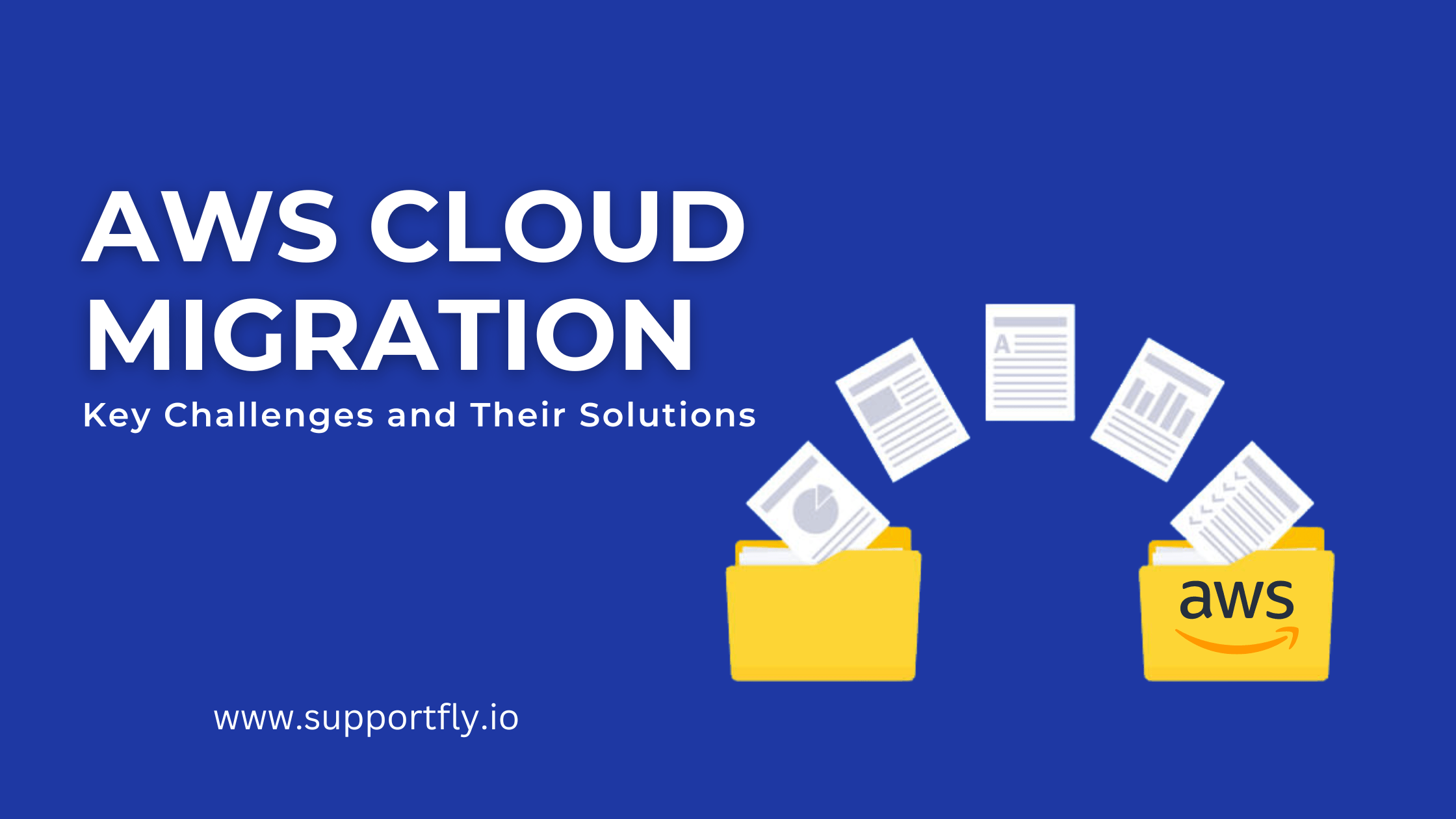
AWS Cloud Migration: Key Challenges and Their Solutions
Migrating to the cloud is an important step for many organizations as it enables them to gain access to the flexibility, scalability, and cost-efficiency offered by cloud computing. Among cloud providers, Amazon Web Services (AWS) is one of the most popular due to its wide range of services and features. However, AWS cloud migration is not without its challenges, and organizations need to be aware of the potential issues they may face during the AWS cloud migration process. One simple way to overcome these challenges is to hire AWS server support from SupportFly. They are the best in business. For a more detailed description of these key challenges of AWS cloud migration and their solutions, keep on reading.

What is AWS cloud migration?
AWS cloud migration is the process of moving an organization’s data, applications, and IT infrastructure from on-premises environments to the Amazon Web Services (AWS) cloud. This migration involves transferring physical or virtual servers, databases, storage, and other IT resources to AWS, where they can be accessed and managed through cloud-based services. The goal of AWS cloud migration is to enable organizations to take advantage of the benefits of cloud computing, such as scalability, flexibility, and cost-efficiency while reducing the complexity and costs associated with managing their own IT infrastructure. AWS provides a range of tools and services to help organizations migrate to the cloud, including AWS Database Migration Service, AWS Server Migration Service, and AWS Migration Hub.
Benefits of AWS cloud migration
There are several benefits of AWS cloud migration, including:
- Scalability: AWS allows organizations to scale their IT infrastructure up or down quickly and easily, depending on their business needs. This means that they can handle sudden spikes in traffic or demand without having to invest in additional hardware or resources.
- Cost-efficiency: AWS offers a pay-as-you-go pricing model, which means that organizations only pay for the resources they use. This can lead to significant cost savings, as they don’t have to invest in expensive hardware and infrastructure upfront.
- Flexibility: AWS provides a wide range of services and tools that can be customized to meet the specific needs of each organization. This allows them to build and deploy applications quickly and easily, without having to worry about managing their own IT infrastructure.
- Improved performance: AWS provides a global network of data centers, which means that organizations can deploy their applications closer to their users. This can lead to improved performance and reduced latency.
- Security: AWS offers a range of security features, such as encryption, identity and access management, and compliance certifications, to help organizations protect their data and applications. AWS also has a team of security experts who monitor the platform 24/7 to detect and respond to any security threats.
- Disaster recovery: AWS provides a range of disaster recovery options, such as backup and replication services, to help organizations protect their data and applications in the event of a disaster.
Challenges of AWS Migration and their solutions
Challenge #1: Identifying the Right Migration Strategy
One of the first challenges that organizations face when migrating to AWS is choosing the right AWS cloud migration strategy. There are several strategies to choose from, including rehosting, re-platforming, repurchasing, refactoring, and retiring. Each strategy has its own benefits and drawbacks, and choosing the wrong strategy can lead to delays, increased costs, and suboptimal outcomes.
Solution:
To overcome this challenge, organizations should conduct a comprehensive analysis of their existing IT environment and business requirements. This analysis will help them identify the right AWS cloud migration strategy that aligns with their goals, budgets, and timelines. It’s important to consult with AWS cloud migration experts who can provide guidance on the best approach for your organization.
Challenge #2: Security Risks
Security is always a top concern for organizations, and cloud migration introduces new security risks. Organizations need to ensure that their data is secure both during the migration process and after it’s moved to the cloud. They must also comply with industry and government regulations to avoid legal and financial penalties.
Solution:
To address security risks, organizations should take a holistic approach that covers the entire migration process. This includes implementing appropriate security controls, performing regular vulnerability assessments, and using encryption to protect data in transit and at rest. AWS provides a range of security features, such as identity and access management, encryption, and compliance certifications, to help organizations meet their security requirements.
Challenge #3: Data Migration
Data migration is one of the most complex and time-consuming aspects of AWS cloud migration. It involves moving large volumes of data from on-premises environments to AWS while ensuring data integrity and minimizing downtime.
Solution:
To address data migration challenges, organizations should develop a comprehensive migration plan that includes a detailed data migration strategy. They should also use AWS migration tools, such as AWS Database Migration Service, to streamline the migration process and minimize downtime. Testing is crucial to ensure that data is migrated correctly and that applications continue to function as expected after the migration.
Challenge #4: Cost Management
AWS Cloud migration can result in significant cost savings for organizations, but it can also lead to unexpected costs if not managed properly. Organizations need to understand the pricing model of AWS and plan for ongoing costs such as data storage, data transfer, and software licensing.
Solution:
To manage costs, organizations should develop a detailed cost management plan that includes a comprehensive understanding of the AWS pricing model. They should also leverage AWS cost management tools such as AWS Cost Explorer to monitor and optimize costs. Organizations can also consider using AWS Reserved Instances to reduce their AWS costs.
Challenge #5: Application Compatibility
Applications that are designed for on-premises environments may not be compatible with AWS, which can cause delays and additional costs during the migration process. Organizations need to ensure that their applications are compatible with AWS and that they continue to function as expected after the migration.
Solution:
To address application compatibility challenges, organizations should conduct a thorough assessment of their applications to identify any compatibility issues. They can also use AWS Migration Hub to track the progress of their application migration and ensure that their applications continue to function as expected after the migration. AWS also provides a range of tools and services, such as AWS Elastic Beanstalk and AWS Lambda, to help organizations modernize their applications for the cloud environment.
Challenge #6: IT Staff Skills
AWS Cloud migration requires a different set of skills and expertise than traditional on-premises IT environments. Organizations may not have the necessary skills in-house to manage their cloud environment, which can lead to delays and increased costs.
Solution:
To address skills gaps, organizations should provide training and development opportunities for their IT staff to build cloud skills and expertise. They can also consider partnering with AWS migration experts who can provide guidance and support throughout the migration process.
Conclusion
AWS cloud migration can offer significant benefits for organizations, including flexibility, scalability, and cost-efficiency. However, it’s important to be aware of the potential challenges and develop a comprehensive plan to address them. By following best practices and leveraging AWS tools and services, organizations can overcome these challenges and successfully migrate to the cloud.
AWS server support services from SupportFly make it really very easy for you to overcome these challenges. Our AWS cloud experts make sure that your AWS cloud migration is smooth and they follow all the necessary guidelines to make sure that these challenges are solved. If you are looking for AWS migrations services, look no further than SupportFly, our services are top notch and the prices are the lowest in the market. Our AWS cloud support is available 24×7 for resolving all issues. Visit SupportFly now to enjoy the best AWS migration services.















